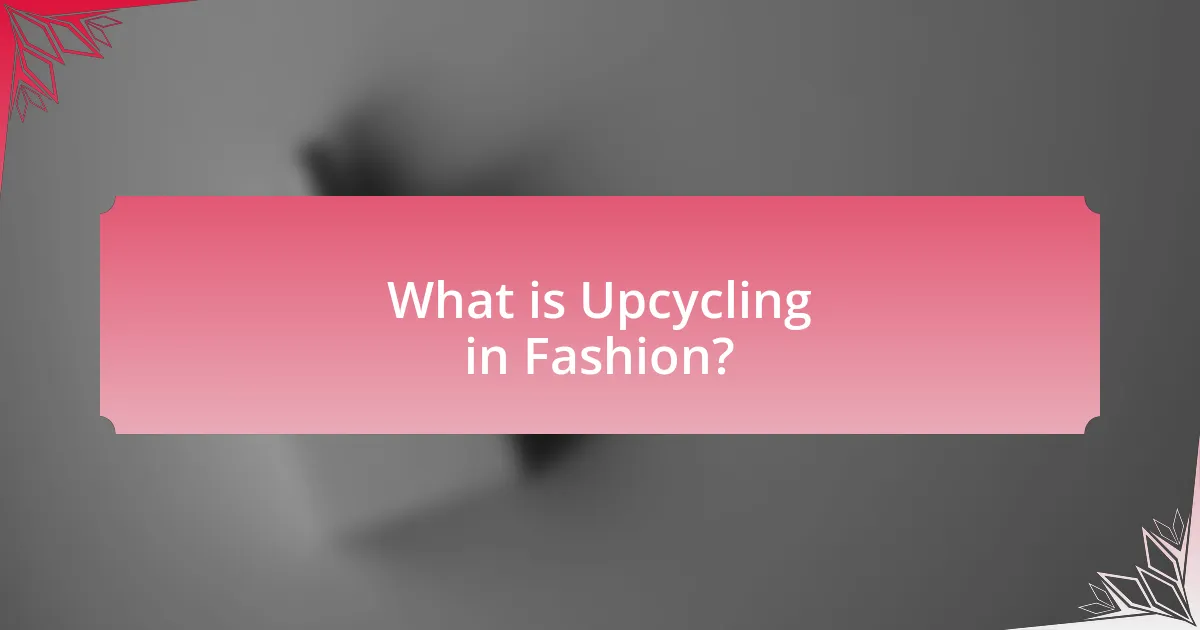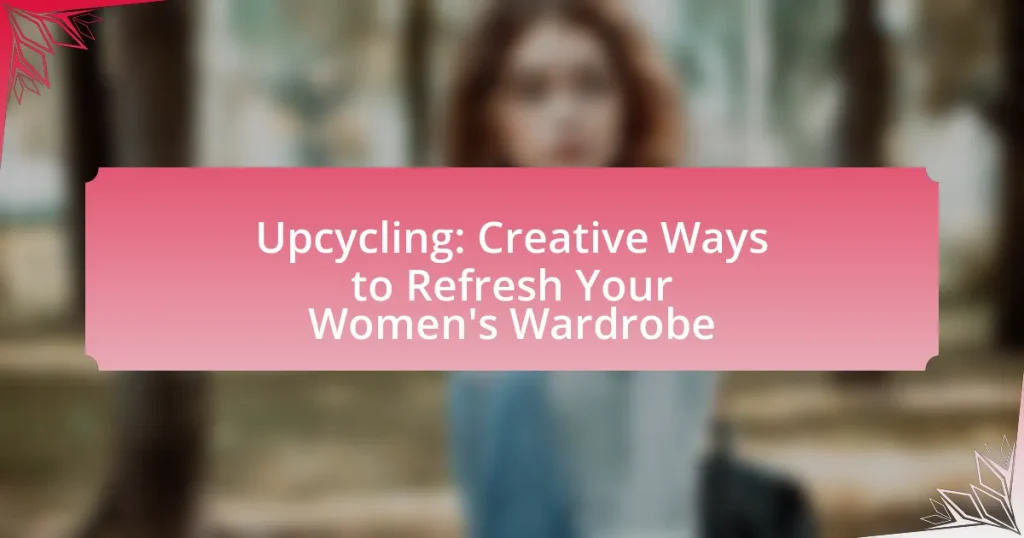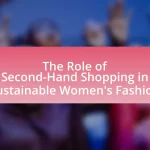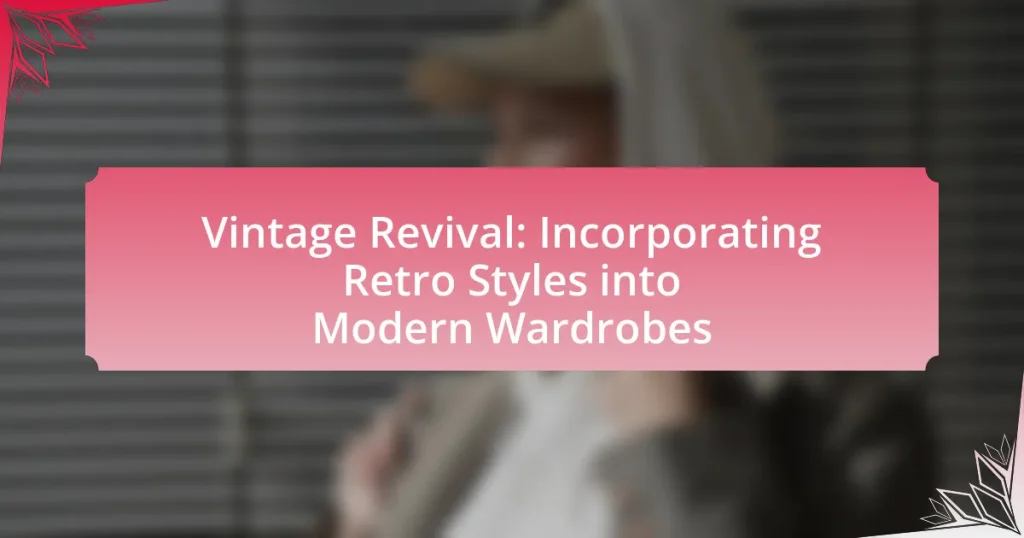Upcycling in fashion refers to the process of transforming old or discarded clothing and materials into new, higher-quality items, promoting sustainability and creativity within the industry. This article explores the differences between upcycling and traditional recycling, the materials suitable for upcycling in women’s fashion, and the importance of this practice for reducing environmental impact. It also provides practical tips for beginners, including easy projects, essential tools, and innovative ideas for repurposing clothing and accessories. By engaging in upcycling, individuals can refresh their wardrobes while contributing to a more sustainable fashion ecosystem.

What is Upcycling in Fashion?
Upcycling in fashion is the process of transforming old or discarded clothing and materials into new, higher-quality items. This practice not only reduces waste but also encourages creativity and sustainability within the fashion industry. According to a report by the Ellen MacArthur Foundation, upcycling can significantly decrease the environmental impact of fashion by extending the lifecycle of garments and minimizing the need for new resources.
How does upcycling differ from traditional recycling?
Upcycling differs from traditional recycling in that upcycling transforms waste materials into new products of higher value or quality, while traditional recycling processes materials to create new raw materials. Upcycling often involves creative and artistic methods to repurpose items, such as turning old clothing into fashionable accessories, whereas traditional recycling typically focuses on breaking down materials like plastics or metals for reuse in manufacturing. This distinction highlights that upcycling emphasizes innovation and enhancement, whereas traditional recycling prioritizes material recovery and sustainability.
What materials can be upcycled in women’s fashion?
Various materials can be upcycled in women’s fashion, including denim, cotton, silk, leather, and polyester. Denim is often transformed into new garments or accessories due to its durability and versatility. Cotton, being a widely used fabric, can be repurposed into different clothing items or home textiles. Silk can be upcycled into elegant pieces, while leather can be reworked into bags or jackets. Polyester, commonly found in fast fashion, can also be recycled into new clothing, reducing waste. Upcycling these materials not only minimizes environmental impact but also promotes sustainable fashion practices.
Why is upcycling important for sustainable fashion?
Upcycling is important for sustainable fashion because it reduces waste and minimizes the environmental impact of clothing production. By transforming discarded materials into new garments, upcycling extends the lifecycle of textiles, thereby decreasing the demand for new resources and lowering carbon emissions associated with manufacturing. According to a report by the Ellen MacArthur Foundation, the fashion industry is responsible for 10% of global carbon emissions, highlighting the need for practices like upcycling to mitigate this issue.
What are the key principles of upcycling?
The key principles of upcycling include creativity, sustainability, and resourcefulness. Creativity involves reimagining and transforming discarded materials into new, functional items, allowing for unique designs that reflect personal style. Sustainability emphasizes reducing waste by extending the life cycle of products, thereby minimizing environmental impact. Resourcefulness focuses on utilizing available materials effectively, often incorporating items that would otherwise be thrown away. These principles collectively promote a circular economy, where materials are reused and repurposed, contributing to environmental conservation and reducing the demand for new resources.
How can creativity enhance the upcycling process?
Creativity enhances the upcycling process by enabling innovative transformations of discarded materials into functional and aesthetically pleasing items. This innovation allows individuals to envision new uses for old garments, thereby increasing the potential for unique fashion statements. For instance, a study by the Ellen MacArthur Foundation highlights that creative approaches to upcycling can significantly reduce textile waste, as they encourage consumers to repurpose items rather than dispose of them. By fostering a mindset of creativity, individuals can explore diverse techniques such as sewing, dyeing, or embellishing, which not only extend the life of clothing but also promote sustainable fashion practices.
What role does resourcefulness play in upcycling?
Resourcefulness is essential in upcycling as it enables individuals to creatively repurpose materials and items that would otherwise be discarded. This skill allows for innovative solutions to transform old clothing or accessories into new, functional pieces, thereby reducing waste and promoting sustainability. For instance, a study by the Ellen MacArthur Foundation highlights that upcycling can significantly decrease the environmental impact of the fashion industry by extending the lifecycle of products. Resourcefulness not only fosters creativity but also encourages a mindset of sustainability, making it a crucial component in the upcycling process.
How can you start upcycling your women’s wardrobe?
To start upcycling your women’s wardrobe, begin by assessing your existing clothing items for potential transformations. Identify pieces that can be altered, such as dresses that can be shortened, shirts that can be turned into bags, or jeans that can be distressed. Research shows that upcycling not only reduces waste but also encourages creativity, with studies indicating that 60% of consumers are interested in sustainable fashion practices. By utilizing sewing techniques, fabric paint, or embellishments, you can give new life to old garments, making them unique and personalized.
What are some easy upcycling projects for beginners?
Some easy upcycling projects for beginners include transforming old t-shirts into tote bags, repurposing glass jars into decorative storage containers, and turning worn-out jeans into stylish shorts. These projects require minimal materials and skills, making them accessible for those new to upcycling. For instance, creating a tote bag from a t-shirt involves cutting the sleeves and hem, then tying the bottom, which can be completed in under an hour. Repurposing glass jars can involve simple painting or adding twine for a rustic look, while converting jeans into shorts only requires cutting and fraying the edges. These projects not only promote sustainability but also allow individuals to express their creativity.
How can you transform old t-shirts into stylish tops?
To transform old t-shirts into stylish tops, you can cut, sew, or embellish them to create new designs. For instance, cutting the t-shirt into a crop top or off-the-shoulder style can instantly modernize its look. Additionally, sewing in darts or adding a belt can enhance the fit and silhouette. Embellishing with fabric paint, patches, or lace can also add a unique touch. These methods not only refresh the garment but also promote sustainable fashion by reducing waste.
What techniques can be used to upcycle denim into new pieces?
Techniques to upcycle denim into new pieces include patchwork, where different denim scraps are sewn together to create unique designs; cutting and reconstructing, which involves altering the shape or length of existing denim items; and dyeing, where fabric dye is applied to change the color or pattern of the denim. Additionally, embellishing with embroidery or appliqué can enhance the aesthetic of upcycled denim. These methods not only reduce waste but also allow for personalized fashion statements, as seen in various DIY upcycling projects that have gained popularity in sustainable fashion movements.
What tools and materials do you need for upcycling?
To upcycle effectively, you need basic tools and materials such as scissors, a sewing machine, fabric glue, paint, brushes, and various types of fabric or clothing items. Scissors are essential for cutting fabric, while a sewing machine allows for more durable stitching. Fabric glue provides a quick alternative for attaching materials without sewing. Paint and brushes enable you to add designs or colors to items, enhancing their aesthetic appeal. Various fabric types, including old clothing, linens, or upholstery, serve as the primary materials for transformation. These tools and materials are commonly used in upcycling projects, making them fundamental for anyone looking to refresh their wardrobe creatively.
Which sewing supplies are essential for upcycling projects?
Essential sewing supplies for upcycling projects include fabric scissors, a sewing machine, thread, pins, and a measuring tape. Fabric scissors are crucial for cutting materials accurately, while a sewing machine allows for efficient stitching. Thread is necessary for securing pieces together, and pins help hold fabric in place during assembly. A measuring tape ensures precise measurements, which is vital for fitting and design adjustments. These tools collectively facilitate the transformation of old garments into new creations, making them indispensable for successful upcycling.
What additional materials can enhance your upcycling efforts?
Additional materials that can enhance upcycling efforts include fabric scraps, old clothing, buttons, zippers, and embellishments like lace or beads. These materials provide versatile options for transforming outdated garments into stylish new pieces. For instance, fabric scraps can be sewn together to create patchwork designs, while buttons and zippers can be repurposed as decorative elements or functional closures. Utilizing these materials not only fosters creativity but also promotes sustainability by reducing waste in the fashion industry.
What are some creative upcycling ideas for women’s clothing?
Some creative upcycling ideas for women’s clothing include transforming old jeans into a stylish denim skirt, repurposing a vintage dress into a trendy top, and converting oversized sweaters into cozy cropped cardigans. These methods not only refresh the wardrobe but also promote sustainability by reducing textile waste. For instance, according to the Environmental Protection Agency, in 2018, 11.3 million tons of textile waste were generated in the U.S., highlighting the importance of upcycling as a solution to this growing issue.
How can you repurpose accessories through upcycling?
You can repurpose accessories through upcycling by transforming old or unused items into new, functional pieces. For example, you can turn a broken necklace into a bracelet or use fabric scraps from old clothing to create unique hair accessories. Upcycling not only reduces waste but also allows for personalized and creative expression in your wardrobe. Studies show that upcycling can significantly decrease textile waste, contributing to environmental sustainability.
What are some innovative ways to upcycle jewelry?
Innovative ways to upcycle jewelry include transforming old pieces into new items such as pendants, earrings, or bracelets. For example, broken necklaces can be reimagined as unique statement earrings by repurposing individual beads or charms. Additionally, vintage brooches can be attached to hairbands or used as embellishments on clothing, creating a fresh look while preserving the original piece’s charm. Another method involves combining multiple pieces into a single, cohesive design, such as creating a multi-strand bracelet from various chains and beads. These approaches not only reduce waste but also allow for personalized, one-of-a-kind accessories that reflect individual style.
How can scarves be transformed into new fashion items?
Scarves can be transformed into new fashion items by repurposing them into accessories such as headbands, bags, or belts. For instance, a long scarf can be braided and tied to create a stylish headband, while multiple scarves can be sewn together to form a unique tote bag. This method of upcycling not only reduces waste but also allows for personalized fashion statements, as seen in various DIY fashion blogs and tutorials that showcase these transformations.
What are some unique clothing transformations through upcycling?
Unique clothing transformations through upcycling include converting old jeans into stylish bags, transforming oversized shirts into fitted dresses, and repurposing sweaters into cozy pillow covers. These transformations not only extend the life of garments but also promote sustainability in fashion. For instance, a study by the Ellen MacArthur Foundation highlights that upcycling can significantly reduce textile waste, with the potential to save 1.5 million tons of clothing from landfills annually.
How can you turn a long dress into a trendy skirt?
To turn a long dress into a trendy skirt, simply cut the dress at the desired length, ensuring a clean hem. This method allows for the transformation of a dress into a fashionable skirt while maintaining the original fabric’s style. Additionally, using a sewing machine or fabric glue to secure the hem can enhance durability and finish. This technique is widely recognized in upcycling fashion, where repurposing clothing reduces waste and promotes sustainability.
What are the steps to create a new outfit from multiple pieces?
To create a new outfit from multiple pieces, first, select a base piece, such as a top or bottom, that you want to build around. Next, choose complementary items like layers, accessories, or contrasting colors that enhance the base piece. Then, experiment with different combinations by trying on the selected items together to assess their fit and style. Finally, finalize the outfit by adding finishing touches, such as accessories or shoes, to complete the look. This method allows for creativity and personalization, making use of existing wardrobe items effectively.
What are the benefits of upcycling your wardrobe?
Upcycling your wardrobe offers several benefits, including environmental sustainability, cost savings, and personal creativity. By transforming old clothing into new items, individuals reduce textile waste, which contributes to the estimated 92 million tons of textile waste generated globally each year. This practice also allows for significant savings, as upcycling can be more economical than purchasing new garments. Furthermore, upcycling fosters creativity, enabling individuals to express their unique style and personalize their clothing, which can enhance self-esteem and satisfaction with their wardrobe.
How does upcycling contribute to personal style?
Upcycling contributes to personal style by allowing individuals to create unique, customized clothing and accessories that reflect their personal tastes. This process transforms discarded items into fashionable pieces, enabling wearers to express individuality and creativity. For instance, a study published in the Journal of Fashion Marketing and Management highlights that consumers who engage in upcycling often report a stronger sense of identity and personal expression through their clothing choices. By repurposing materials, upcycling not only promotes sustainability but also fosters a distinctive wardrobe that sets individuals apart from mainstream fashion trends.
What environmental benefits come from upcycling clothing?
Upcycling clothing significantly reduces environmental impact by minimizing waste and conserving resources. When clothing is upcycled, it diverts textiles from landfills, where they can take decades to decompose, thus reducing landfill overflow. Additionally, upcycling decreases the demand for new materials, which in turn conserves water and energy used in the production of new garments. For instance, producing a single cotton t-shirt requires approximately 2,700 liters of water; by upcycling, this resource-intensive process is avoided. Furthermore, upcycling can lower carbon emissions associated with manufacturing and transportation of new clothing, contributing to a decrease in overall environmental pollution.
What tips can help you successfully upcycle your wardrobe?
To successfully upcycle your wardrobe, start by assessing your current clothing items for potential transformations. Identify pieces that can be altered, such as turning a long dress into a stylish top or adding embellishments to outdated garments. Utilize sewing techniques, like patching or dyeing, to refresh the look of your clothes. Research shows that upcycling can reduce textile waste significantly, with the Ellen MacArthur Foundation reporting that extending the life of clothing by just nine months can reduce carbon, water, and waste footprints by 20-30%. Additionally, consider swapping clothes with friends or participating in local clothing exchanges to diversify your wardrobe without purchasing new items.
How can you find inspiration for your upcycling projects?
To find inspiration for your upcycling projects, explore various sources such as social media platforms, DIY blogs, and community workshops. Social media platforms like Pinterest and Instagram showcase countless creative ideas and tutorials, allowing you to visualize potential projects. DIY blogs often provide step-by-step guides and innovative concepts that can spark your creativity. Additionally, participating in community workshops can expose you to new techniques and ideas while connecting you with like-minded individuals. These sources collectively offer a wealth of inspiration, making it easier to refresh your wardrobe through upcycling.
What common mistakes should you avoid when upcycling clothing?
Common mistakes to avoid when upcycling clothing include not planning the project, which can lead to wasted materials and time. Failing to choose the right fabric for the intended design can result in poor durability and appearance. Additionally, neglecting to measure accurately can cause ill-fitting garments, while overlooking the importance of proper tools may hinder the quality of the finished product. Lastly, not considering the garment’s original structure can limit creativity and functionality in the upcycled piece.














